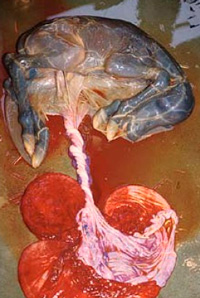Equine Herpesvirus type 1 and type 4 as a cause of abortion

Dr. Richard Newton (Animal Health Trust, Reino Unido)
Equine Herpesvirus type 1 (EHV-1) and type 4 (EHV-4) are common viruses distributed worldwide which produce respiratory disease in young horses, abortion in mares and myeloencephalopathy in horses of any age (only caused by EHV-1).
Although there are reports of both EHV-1 and EHV-4 causing abortion in mares (mainly those mares without a history of vaccination against EHV-1/-4), EHV-4 has been associated with individual cases and it is not considered a risk for abortions storms (which is however common in cases of infection with EHV-1). Both herpesvirus cause neonatal disease and death; in these cases the foals are born alive but present with pneumonia and die several hours after birth.
Very often, there are no premonitory signs of abortion in the infections with EHV-1/-4. A sudden, unexpected abortion with an icteric foetus and icterus in placenta should always be taken with precaution and be considered as a suspicion of EHV-1/-4 infection. Similarly, a foal born weak or with respiratory disease, or a foal dead at birth should always be considered suspicious of being infected by EHV-1/-4.
Which measures should be undertaken in a yard or stud farm when there is a suspicion of abortion caused by EHV-1/-4?
In any abortion with a suspicion of infection with EHV-1/-4, as well as in any cases of neonatal disease or death, the following measures should be undertaken:
- If the foetus and the placenta are intact, these should be introduced in double, leak-proof bags or in a leak-proof, sealed container so that the contamination of the environment and the yard staff is avoided during transport.
- The affected mare must be placed in total isolationo.
- The area where the abortion or the birth of the diseased foal took place should be isolated and signalized in order to avoid the Access of other pregnant mares to the area, and it should be thoroughly disinfected.
- All the breeding activities should be stopped, as well as any movements of horses in or out of the premises should be restricted.
- Appropriate samples should be taken from the foetus and placenta or the diseased foal, as well as from any horses that were in contact with the affected mare, in order to confirm or rule out the infection with EHV-1.
- The bedding (straw/shavings) from the affected mare should be disinfected and destroyed, and the premises should be cleaned and disinfected.
How to diagnose EHV-1/EHV-4?
When there is a suspicion of EHV-1/-4 as the cause of abortion or neonatal death, the most appropriate samples in order to confirm the infection by real time, quantitative PCR are the following:
- A group of samples from the foetus: liver, lung, spleen, adrenal gland and thymus should be included in a sterile container or a container with viral transport medium. If a complementary histopathology diagnosis is wanted, a second batch of samples from the foetus should be included in a container with 10% formalin.
- A group of samples from the placenta: Cervical star, body and both horns included in a sterile tube or a tube with viral transport medium. If a complementary histopathology diagnosis is wanted, a second batch of samples from the placenta should be included in a container with 10% formalin.
In cases of abortion or neonatal disease/death serology is not useful (it is only useful in the unaffected mares without a history of vaccination against EHV-1/-4, and in order to rule out exposure to EHV-1/-4). The most important is to proceed to implement the correct control measures.
If the infection with EHV-1/-4 is confirmed…
If the infection with EHV-1/-4 is confirmed, the following measures should be implemented in the premises:
- Separate pregnant mares which were in contact with the affected mare in small groups with mares which are due to give birth in the same dates. Some of these mares may still abort, so the smaller the groups of mares, the more the risk is minimised.
- Keep the movement restrictions in the premises and the isolation of the affected mare during at least 28 days after the abortion.
- The affected mare can be bred in the second heat (30 days) after the abortion.
- If there are mares which, coming from other premises, were bred in the premises where the abortion caused by EHV-1/-4 took place, they should be kept in isolation until they foal in their own premises.
For further information and the consultation of questions regarding the diagnosis, treatment of equine infectious diseases or measures of prevention and control of an outbreak:
Equine Health Surveillance Unit
VISAVET Health Surveillance Centre
Complutense University Madrid (Spain)
Tel.: (+34) 913943999
seviseq@ucm.es
Bibliography
- Allen, G., Kydd, J., Slater, J. and Smith, K. 1999. Recent advances in understanding the pathogenesis, epidemiology, and immunological control of equid herpesvirus-1 (EHV-1). Equine Infect. Dis.. 8:129-146.
- Diallo S.I., Hewitson G., Wright L., Rodwell B.J., Corney B.G.. 2006. Detection of equine herpesvirus type 1 using a real-time polymerase chain reaction. J. Virol. Meth.. 131:92-98.
- Diallo S.I., Hewitson G., Wright L.L., Kelly M.A., Rodwell B.J., Corney B.G. 2007. Multiplex real-time PCR for the detection and differentiation of equid herpesvirus 1 (EHV-1) and equid herpesvirus 4 (EHV-4). Vet. Microbiol.. 123:93–103.
- Equine rhinopneumonitis. OIE Manual of Diagnostic Tests and Vaccines for Terrestrial Animals 2013. Chapter 2.5.9.
- Bryans J.T., Allen G.P. 1988. Herpesviral diseases of the horse. In: Herpesvirus Diseases of Cattle, Horses and Pigs. Ed. G. Wittmann, Kluwer Academic Publishers, Boston, USA. 176-229.
- Crabb B.S., Studdert M.J. 1955. Equine herpesviruses 4 (equine rhinopneumonitis virus) and 1 (equine abortion virus). Adv. Virus. Res. 45:153-190.
- Gilkerson J.R., Love D.N., Whalley J.M. 1998. Epidemiology of equine herpesvirus abortion: searching for clues to the future. Aust. Vet. J. 76:675-676.
- Mumford J.A., Rossdale P.D., Jessett D.M., Gann S.J., Ousey J., Cook R.F. 1987. Serological and virological investigations of an equid herpesvirus 1 (EHV-1) abortion storm on a stud farm in 1985. J. Reprod. Fertil. Suppl. 35:509-518.
- Schultheiss P.C., Collins J.K., Carman J. 1993. Use of an immunoperoxidase technique to detect equine herpesvirus-1 antigen in formalin-fixed paraffin-embedded equine fetal tissues. J. Vet. Diagn. Invest. 5:12-15.


